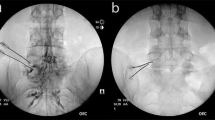Abstract
There are a multitude of potential causes for both residual leg pain and residual back pain following surgery. In a minority of patients there may be pathology from an adjoining segment or recurrence of the preoperatively existent anatomic abnormality. In many others surgery fails because the damage was already irreparable by the time the anatomic abnormality was corrected. In residual leg pain this is due to radiculopathy, with or without centralization into the dorsal horn. In residual back pain inflammation or scar formation in the anterior epidural space plays a major role.
The role of radiofrequency (RF) has been limited for two reasons. First, because RF is destructive in nature, it is contraindicated in the treatment of neuropathic pain. Second, the anterior epidural space is innervated by the sinuvertebral nerve, which runs too close to the main segmental nerve to apply RF safely.
Recently the concept of heat as being the primary active factor in RF lesions has come under discussion and has led to the development of pulsed RF (PRF), which is a nondestructive method of exposing tissue to RF electric fields. Because PRF is nondestructive, it is potentially suitable for the treatment of neuropathic pain and it can also be applied at the origin of the sinuvertebral nerve. The initial clinical results have been promising, but controlled studies are still lacking.
Similar content being viewed by others
References and Recommended Reading
Jensen MC, Brant-Zawadski MN, Obuchoski N, et al.: Magnetic resonance imaging of the lumbar spine in people without back pain. N Engl J Med 1994, 331:69–73.
O’Brien JP: Anterior spinal tenderness in low back pain syndromes. Spine 1979, 4:441–446.
Jaffray D, O’Brien JP: Isolated intervertebral disc resorption. A source of mechanical and inflammatory back pain? Spine 1986, 11:397–401.
Letcher F, Goldring S: The effect of radiofrequency current and heat on peripheral nerve action in the cat. J Neurosurg 1968, 29:42–47.
Sluijter ME, Cosman E, Rittman W, Van Kleef M: The effect of pulsed radiofrequency fields applied to the dorsal root ganglion-a preliminary report. Pain Clin 1998, 11:109–117. This is the first article describing the background, theory, technique, and initial results of PRF.
Katims JJ: Electrodiagnostic functional sensory evaluation of the patient with pain: a review of the neuroselective current perception threshold and pain tolerance threshold. Pain Digest 1998, 8:219–230.
Sluijter ME,Van KleefM,Schleinzer W:Effects of pulsed radiofrequency fields on sensory thresholds. Pain Clin1999,
Van Kleef M, Sluijter ME: Radiofrequency lesions in the treatment of pain of spinal origin. In Textbook of Stereotactic and Functional Neurosurgery. Edited by Gildenberg PH, Tasker RR. New York: McGraw-Hill; 1998:1585–1599. Gives a detailed description of the various RF techniques that are available for the treatment of pain of spinal origin.
Van Kleef M, Barendse GAM, Wilmink JT, et al.: Percutaneous intradiscal radiofrequency thermocoagulation in chronic non-specific low back pain. Pain Clin 1996, 9:259–268.
Author information
Authors and Affiliations
Rights and permissions
About this article
Cite this article
Sluijter, M.E. The role of radiofrequency in failed back surgery patients. Current Review of Pain 4, 49–53 (2000). https://doi.org/10.1007/s11916-000-0009-3
Published:
Issue Date:
DOI: https://doi.org/10.1007/s11916-000-0009-3




